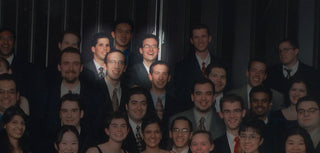
1996
We meet, it's un-monumental
It all started in a digital circuits class. It was 1996. Phil and I were both at the University of Calgary studying to become engineers. As fate would have it, we were paired as lab partners. I’d like to say there was a thunderbolt moment where we both saw our futures unfold in front of us, but it was substantially less monumental than that. We worked well together, largely because we’re both perfectionists. I never had to convince Phil to stay up late to keep working on a project and he never had to convince me to stay up even later. During our time as lab partners we became friends. We were odd ducks in the world of engineering because while most of our cohorts feasted on pizza and beer, even as scruffy students both Phil and I had a taste for the finer things and bonded over a shared love of fine food and wine.
We drink a lot of crappy espresso, until we don't.
In 2002 we discovered espresso and just how good or bad it can be. The discovery happened for both of us accidentally and concurrently. For Phil, the revelation was sparked by his late Uncle Billy. When Phil visited Uncle Billy, who was quite the aficionado, Uncle Billy would meticulously prepare espressos for the two of them to enjoy. The process piqued his curiosity and Phil bought a Gaggia Baby espresso machine and began experimenting. Around the same time I was dropping some rather unsubtle hints to my wife Emily that it would be nice to make espressos at home. You can imagine my surprise when on my birthday a Delonghi espresso maker showed up. Despite using nice beans the results were atrocious and I can quite honestly remember asking myself why anyone would bother to drink the crap. After many discussions between Phil and I, along with some fairly extensive research (this is where it’s beneficial to remember our engineer-like tendencies) the truth was revealed. While Phil’s Gaggia Bay was a decent espresso machine, my Delonghi was essentially useless and would never produce a drinkable espresso. It was immediately exchanged for a Rancilio Silvia. The results went from atrocious to drinkable, but barely.
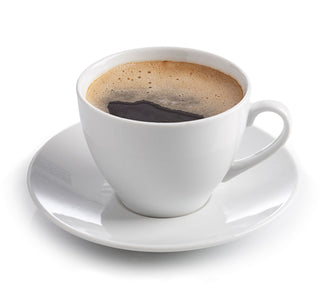
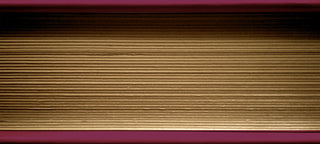
2005
A book changes our lives.
Then fate intervened. Sadly, uncle Billy passed away and in his will he left Phil a book, David Schomer’s Espresso Coffee: Professional Techniques. As ridiculous as it may sound, that book changed our lives. I can honestly say that I don’t know where we would be had it not come into Phil’s possession. It introduced us to the science behind espresso, appealing to the engineer and the budding aficionado in both of us. We were zealots, learning about dosing, distribution, and tamping. We also learned that in order to create a great espresso it was time to invest in another piece of brewing equipment. I went out and purchased a Rancilio Rocky grinder, multiplying my wife’s initial investment in my birthday present by tenfold. But finally, we created something drinkable, and although we didn’t know it at the time, we had also created Phil & Sebastian’s first tasting lab. The cinematic progression of our story would involve the swift opening of a coffee shop. In reality that day was still more than half a decade away. And let’s just say life had a few curveballs planned for us in the meantime.
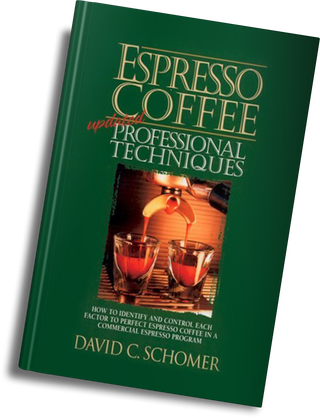
Despite good advice, we road trip.
The tasting lab, also known as my former kitchen, was operating in full swing and we were starting to experiment with other espressos. It was our first cup of Seattle’s Vivace Espresso, roasted by the aforementioned David Schomer that really changed the game. If we’d looked up to the man before his espresso turned admiration into full-blown obsession. Not only did he have his own roasting business, he also had a small cafe where drinks were served small and without syrups. A road trip was in order. We ignored a lot of sound advice, the March road conditions and a severe avalanche warning and headed to Seattle. In tow were two friends who would both become instrumental in the creation of Phil & Sebastian, Joe Oppenheim, a long time friend, who is now our company lawyer, and Jonathan Herman my brother-in-law, a designer and now a guiding force behind our brand (who, as hard as it is to believe, at the ripe age of 21 had never had a cup of coffee).
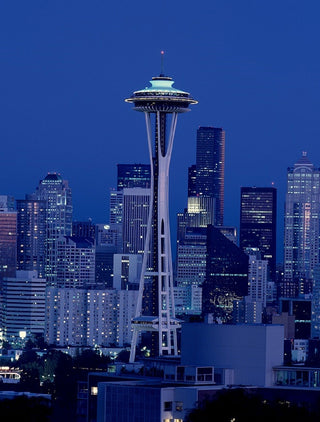
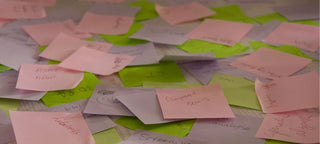
2005
We come up with some horrible names, and struggle through writing a mission statement.
It was during that summer that planning for our own cafe began. Although Phil and I would both consider ourselves fairly proficient at most things in life, naming the business was not our strong suit. We cycled through some embarrassing and in hindsight rather entertaining options such as Ooze Espresso Bar, Atypica Coffee, Latte Art Coffee House (I blame Phil for most of those). We also started putting down on paper our vision, and mission. To date this is one of the most challenging tasks we’ve undertaken. There was a lot of procrastination, a lot of revisions and a lot of late nights. It reminded me of this scene from Seinfeld where Jerry and George are trying to write script for a show about nothing. After the initial enthusiasm, they find themselves staring into space blankly. This lasts for a few seconds until Jerry remembers he has to call Elaine, and George turns on the television. That was Phil and I. We’d sit down, long stretches of silence would ensue until we came up with a distraction or one presented itself. I am happy to admit that after many painful attempts, and well into the fall of 2005, we had a mission statement. The gist was and still is this: We believe that coffee has great potential for flavour and nuance. We want to introduce this potential to our customers, and help them discover just how great coffee can be.
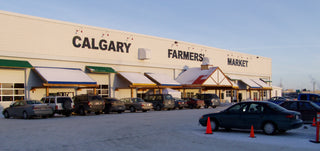
2006
We try and get into the Calgary Farmers' Market.
It was during a trip to the Calgary Farmers’ Market that we finally stumbled across the solution. It was the perfect place to launch. We’d have low initial-overhead, the customers were more discerning and for the most part people weren’t in a rush. However there were a few issues, there was a three-year waiting list, and the market already had two coffee shops. Trying to pitch a third wasn’t going to go over well, so we decided we’d get our foot in the door by pitching a tasting bar for the purposes of selling whole bean coffee and home brewing equipment.
2007
Despite all odds, we pull it together and open at the Market.
Now that we had space secured, and some experience under our belts Phil moved back to Calgary and we got to work. We took possession of Bit O’ Beans on March 12th 2007. The plan was to open for business on March 30th 2007. That’s a fairly tall order for any start-up but it was an especially tall order considering we were two guys with no budget, no drawings and limited construction know-how. We did however have two of the most sophisticated pieces of brewing equipment in the world, a 3-group La Marzocco FB-80 and a Clover by-the-cup brewer (one of three in all of Canada). At the time they were both living in my basement which was operating as our testing lab and also as an impromptu coffee house with friends stopping by to taste our experiments. We approached Karo Design to help us get things started. The budget we managed to scrounge together was measly and to this day I’m not sure why Karo Design agreed to help us, but they did. The construction crew consisted of myself, Phil, my brother Rodrigo who at the time was a carpentry student (he’s now a very established cabinet-maker), Jonathan who isn’t handy, and Sebastian’s brother-in-law Lou, who also wasn’t handy. We were a sorry excuse for a construction team led by a first-year carpentry student. Thankfully a few fateful turns helped us get things on track, most notably the support of our friend the very capable handyman Bruce Weir. None of us are quite sure how it happened, but by the evening of March 29th we were ready for business. Well, almost ready for business, the cash register wasn’t functional so we armed ourselves with a shoebox and a calculator. That night, in a fit of panic that no one but our families would make an appearance, I sent out a 3:00 am email begging everyone I’d ever met to please come by. That first weekend was extremely rewarding. Sales were nothing to write home about, but based on customer feedback, we felt we had succeeded in re-creating our amazing beverage experience from Cafe Vivace years prior, only this time we were on the serving side.
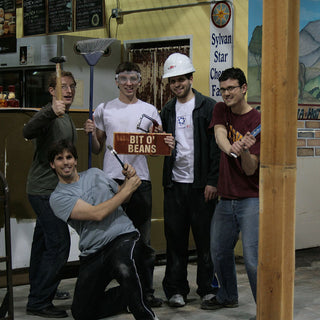
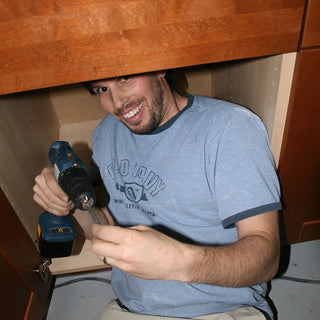
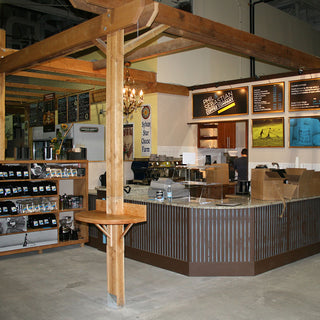
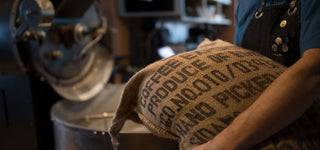
We decide we want to roast our own coffee.
It had always been part of our plan to roast our own coffee, so three months into our venture at the market we started looking into it. We purchased a sample roaster, some green coffee and returned to my basement. Things started off pretty shaky. After much experimentation, we were able to bring out a nice warm brown in the beans. Unfortunately the beans looked gorgeous but tasted terrible. So in true engineer fashion, we spent the next fifteen months researching, reading, roasting, cupping, hiring consultants and flying to San Francisco. By September 2008 we weren’t roasting the best coffee in the world, but we were getting pretty good. We were confident enough in our abilities that it was time to invest in a production roaster.
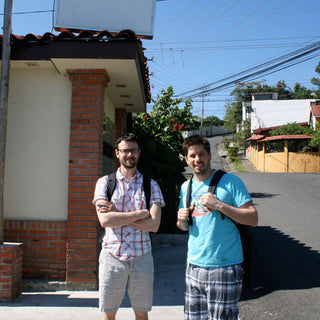
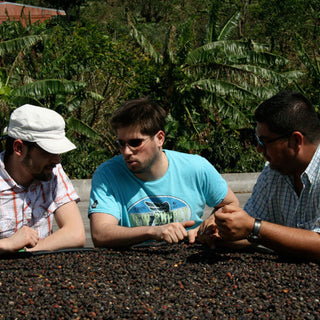
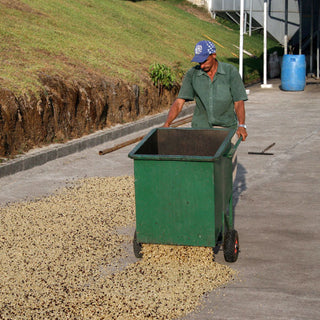


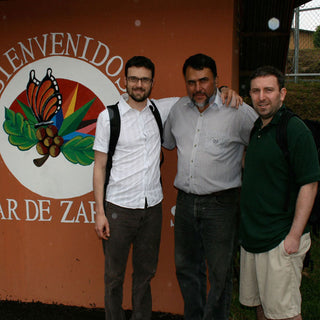
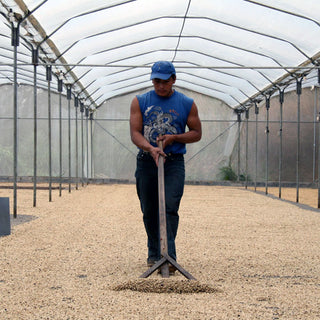
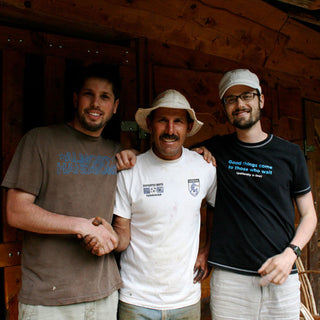
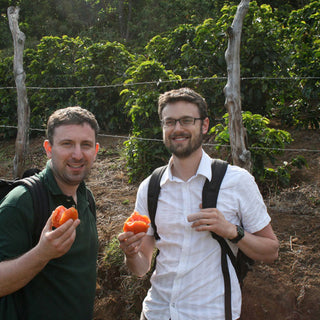
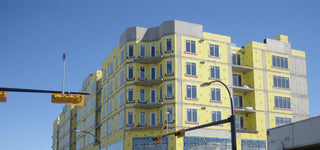
We decide on a Marda Loop location.
Now that we were sourcing and roasting we began to move towards the grand goal of opening our first standalone cafe. We knew we didn’t want to churn out lattes like they were coming off a conveyor belt. We wanted a place where people could sit, engage about coffee and savour with more of a neighbourhood vibe. So opening a shop in Marda Loop made a lot of sense.
McKinley Burkart woos us.
We were approached by Walker McKinley of McKinley Burkhart, a very reputable Calgary-based architecture and design firm. At the time we were loosely engaged in discussions with another design firm, but decided to take the meeting anyways. As impressive as their portfolio was, it wasn’t what won us over. Not only did they appreciate what we were trying to do with coffee, they also brought a similar level of passion and dedication to their own craft. Much like Phil and I, Walker and Mark are also perfectionists. It’s made for some intense conversations, but ultimately very fruitful results.
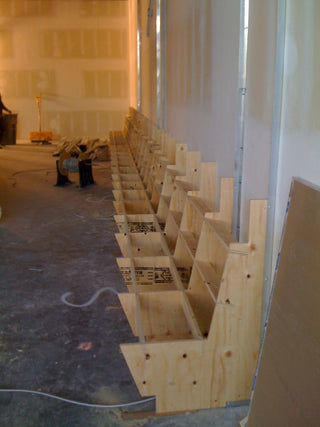
Artistic tension ensues.
Initially, the Marda Loop space was slotted for a Sobeys and they had exclusivity on coffee; fortunately for us, that deal fell through. At the time the developer already had another tentative deal but we ultimately won out due to the fact that we were small and locally owned, not a large chain. So with the help of McKinley Burkhart and Jonathan, we began plans to create a space that was noisy, bright, classy and focused entirely around coffee. We had many meetings – many tense meetings – and some outright fights but finally we were ready to begin construction.
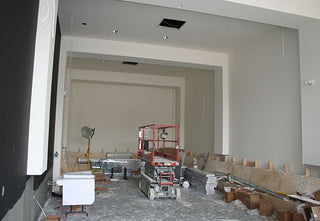
I send out frantic emails the night before a big opening.
On the evening of Friday November 27th, construction was complete and we were ready for business. In the same tradition of panicked pre-opening emails, I once again sent out a late night request begging people to come by. Thankfully on Saturday November 28th, 2009 our first cafe opened to a small crowd, stayed busy all day and has pretty much been that way ever since. It was a banner moment for Phil and I. We had spent six years eating, sleeping and dreaming about creating our own cafe.


It seems weird at first, but we decide to open at Chinook Mall.
There was a fellow named Ron who came by the market fairly regularly. We had good conversations around coffee, and our operations, but it never occurred to me that he was actually conducting informal research until we got a call from our broker asking if we wanted to sit down with Darryl Schmidt: the leasing manager for Chinook Centre. Turns out Ron was actually the VP of Cadillac Fairview, the company that owns and operates Chinook mall. He had tasked Darryl (whom we now affectionately refer to as “Schmitty”) with figuring out what it would take to get us in there. After our first meeting with Schmitty it was time for some soul searching. A mall wasn’t where we saw ourselves. We don’t like malls, so it didn’t make sense to open in one; but then we went back to our mission statement. If we wanted to bring great coffee to the masses, we needed to go to where the masses were. We went back to Schmitty with our list of demands. We needed our own entrance so it could feel like our own space. We needed space for our own seating area. We needed to not be in the food court. We are not about convenience; we are about an experience so the further people have to walk to find us, the easier it is to engage folks and the more interested they are in what we are doing. We had to create an out-of-mall experience in the mall. Schmitty being the great guy that he is was nothing but accommodating. We opened in September 2010.
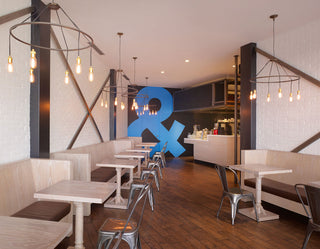
We part ways with the Calgary Farmers' Market.
Around the same time design started for Chinook, the Calgary Farmers’ Market announced that it was moving locations. We loved being in the market, loved the energy, the customers, and the vendors (most of them), but because of struggles at the board level there wasn’t an articulate vision of where the market was going, and we decided it didn’t make sense for us to continue on. It was with heavy hearts we said goodbye and parted ways.
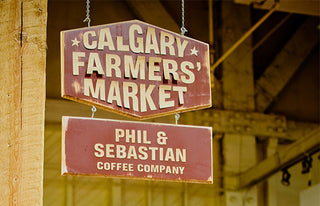
We lose money. It sucks.
Sales at Chinook were not what we had hoped. We had just closed down a profitable operation at the market and we were losing money at an alarming rate. We hadn’t encountered this kind of adversity before. During those first three years we’d largely made decisions without ever considering the financial implications; our main goals as a business weren’t monetary so it hadn’t felt necessary. But we shortly realized that the sustainability of Phil & Sebastian would require us to pay more attention to how we spent our time and our money. There wasn’t a magic button, or genius insight, we just didn’t panic. Or we didn’t panic a lot. We stuck with what we knew we were good at: making tasty coffee and sharing it with Calgary. We also developed a more responsible approach to our finances. By the end of the year we were close to breaking even.
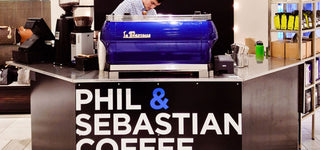
We open in Holt Renfrew. It works until it doesn't.
Our overarching goal throughout this process had been to share how great espresso could truly be, so a mobile coffee bar seemed to make a lot of sense. We worked with Aerotech Metal and designed a bar that would fit nicely into a trailer. Unfortunately as enjoyable as it was being outdoors at Calgary Folk Fest and other similar events, the logistics made the endeavor too time and effort intensive to be financially viable. We decided the mobile cafe should act as a semi-permanent installation staying in place for a few weeks at a time. Our first opportunity came at Holt Renfrew, which we were initially wary of. We believe we offer a high-end product, but we’ve never been about exclusivity. However there were advantages, it offered some great exposure and a test of the downtown market. We decided to go for it and two weeks turned into 18 months. But in the end the relationship didn’t make sense. We were buried in the back, the store hours and coffee drinking hours weren’t aligned, and ultimately it just wasn’t a fit for our respective brands.
We partner with Folk Fest.
One of the highlights of our mobile espresso bar stint was our introduction to the Calgary Folk Festival. In 2011, we setup our mobile espresso bar at the Folk Fest. It was actually our first mobile event and we barely survived it. We were not really prepared to launch, let alone at an event featuring thousands of cold, coffee-deprived music fans. Nonetheless, we enjoyed Folk Fest a great deal and our involvement in the festival has grown every year since then and since 2013, we have been the coffee sponsors of the event and have served almost 30,000 coffees in that span.
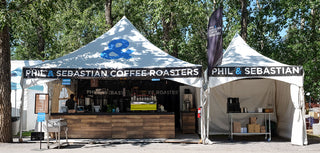
Our baristas kill it at the Barista Championships.
We first participated at the Canadian Barista Championships in 2008. It’s a strange subculture of coffee nerds, but as you can imagine we found ourselves very much at home and we’ve been hooked ever since. In 2009, one of our baristas, Ben Put competed in the precursor to the national competition and came in first, much to our dismay he didn’t qualify for finals at the nationals but in some ways it was for the best. It lit a fire in Phil and I and we were determined to help Ben improve. Since then, we’ve been fortunate to enjoy a great deal of success. We have finished second or first in Canada every year since 2010. In 2010, 2011 and 2012, Ben finished second. In 2012, we groomed another one of our baristas, Jeremy Ho, helping him win the Canadian Barista Championship. Phil and I coached Jeremy to a 9th place finish out of 53 countries, which we all felt pretty good about. In 2013, we helped Ben get through the hump and he finally won the Canadian Barista Championship. Another barista from our team, Megan Feniak, placed 4th, making her the top-ranked female barista in the country. This was an amazing accomplishment for Megan, especially considering she was a first-time competitor.
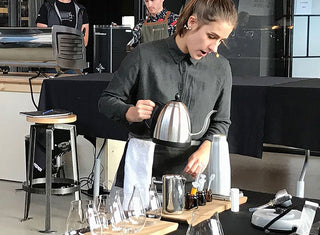
We go back to a Farmers' Market.
In 2013 I got a call from Darrell (the old GM of the Calgary Farmers’ Market who along with Bob gave us our start) telling me that he had found the perfect northwest location for us. Of course I was skeptical, but because of our history I took the meeting. He drove me out to a very large, multi-level log house that had once been used for events. The roof was falling apart, there were more than a few dead birds and it had the distinct odor of neglect. I wasn’t sold. Then Darrell started sharing his vision for the property. He wanted to turn it into a farmer’s market, and had long-term plans for revitalizing the entire property. I still wasn’t sold, but agreed to stay in touch. I headed back with Phil by my side a few months later, unfortunately the property was in pretty much the same condition. I believe the term Phil used was ‘gross’, which accurately echoed my own initial impression. Still Darrell’s vision was becoming more and more apparent in my mind, again we agreed to stay in touch. Another month went by and we returned, this time the charm didn’t require so much imagination. We decided to jump on board, we moved the mobile bar from Holt Renfrew and on July 18th opened up at Symons Valley Ranch. It feels great to be back at a farmers’ market and the ranch is quickly becoming a go-to northwest destination.

We open a location in Mission, it serves booze.
We’d known for a long time we wanted to open a location in the charming Mission district. The vibe of the neighbourhood felt like the right fit. So when we had to opportunity to open on what is known as the Maxwell Bates block, named after the local artist, we jumped. We reunited with Walker and Mark from McKinley Burkart and got to work. When we began designing the Mission cafe, we were intent on creating a completely different cafe experience. We were tired of the fast food model of cafes where you “order here” and “pickup there”. We had, and still have, a good idea of how to change this. Unfortunately, rent on 4th street is ridiculously expensive and the space required to do what we want to do is simply too much for this location, so it may have to wait until another day (hint, hint: Simmons). We had long since toyed with the idea of serving a small, curated menu of wine and beer and this seemed like the right time to do it. We worked with our friends Elliot and Matt from Highlander Wine & Spirits and Eric from Dreamwines to create a small menu that fits with the cafe — elegant, approachable and tasty. We didn’t want to become a bar, we just wanted to add another dimension to the evening vibe, and so far we’ve done exactly that.
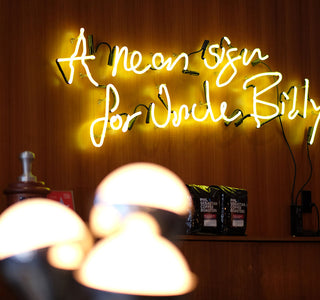
Turns out East Village is pretty cool.
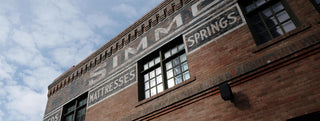
In January 2012 we got a call asking if we’d be interested in opening a cafe in the East Village. Our initial reaction was “Not interested. We need people to have a cafe.” But we decided to swing by and check out the neighbourhood. During our tour of the East Village, we drove by the Simmons building and something instantly clicked, and we knew we wanted to be part of it. It had been in the back of our heads for some time to combine a roasterie with a cafe and this felt like the perfect fit. But the space was bigger than we needed for even that, so we decided if we were really going to turn the Simmons building into a place that attracted people from morning until night, we needed to call on a few friends. That day, I called John and Connie from Charcut, and Aviv from Sidewalk Citizen and asked them to come a look at the space with us. Within five minutes everyone was onboard. Together we submitted a proposal to the city that envisioned the building as a concept cafe, roasterie, bakery, deli and restaurant, a deep-knit collaboration between three partners allowing us to offer a completely unique culinary experience. We’re now in the design stage and so far it’s proven to be a tricky endeavour, all three partners have to balance their individual needs with the common good of the space but we’re all excited with how it will come together and are really looking forward to seeing the role the space plays in shaping the neighbourhood.
When we designed the Mission cafe, we really wanted to reinvent the cafe experience and this will be the goal at Simmons: to make customers slightly uncomfortable. I don’t mean that in a rude way, but we want to push customers out of their comfort zone so we can all share in a new experience.
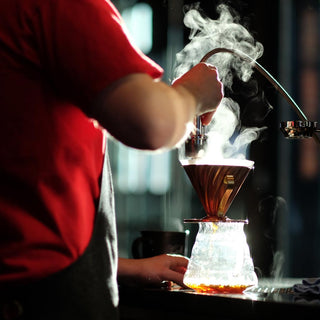
The crystal ball.
I don’t think either Phil or I are entirely sure about what the future holds. What we do know is that for both of us this has always been a labour of love. We’re engineers and coffee lovers first, and businesspeople second. Along the way the bumps on the road have taught us to keep an eye towards sustainability, but for the most part our focus is where it’s been since day one, creating great coffee and sharing it with folks that appreciate it. Despite our growing business we still get to spend an inordinate amount of time being coffee nerds, which is exactly how we like it.










